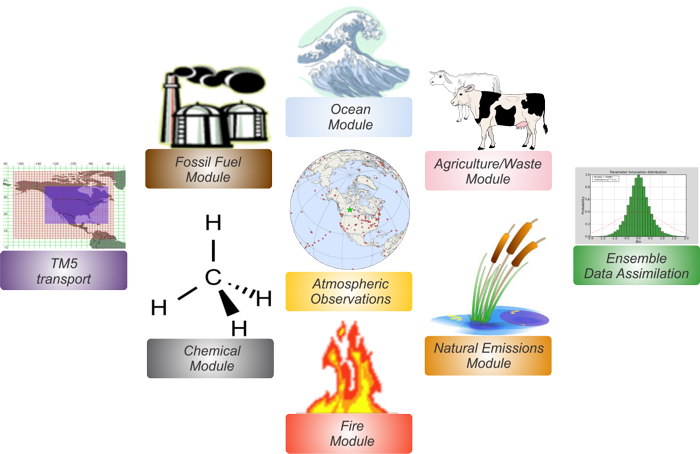Information
Home FAQ Project Goals Documentation Collaborators TutorialResults
Fluxes Observations Evaluation Visualization DownloadGet Involved
Suggestions E-mail List Contact UsResources
How to Cite Version History Glossary References Bibliography
To learn more about a CarbonTracker component, click on one of the above images.
Or download the full PDF version for convenience.
Fire
Introduction
Fire is an important part of the carbon cycle and has been for many millennia. Even before human civilization began to use fire to clear land for agricultural purposes, most ecosystems were subject to natural wildfires. These fires rejuvenated old forests in various ways including reintroducing important minerals to the soils. As fires consume a landscape, in either controlled or natural burning, carbon dioxide, carbon monoxide and methane (amongst many other gases and aerosols) are released in significant quantities. Each year, vegetation fires emit around 2 PgC as CO2 into the atmosphere, mostly in the tropics. Fires are a relatively small part of the atmospheric CH4 budget: ~15-20 TgCH4/yr out of a total of ~520 TgCH4/yr, however, they are an important contribution to the inter-annual variability of methane. Currently, a large fraction of these fires are started by humans, with most of them started intentionally to clear land for agriculture, or to re-fertilize soils before a new growing season. Fires are monitored mostly from space, with sophisticated 'biomass burning' models that are used to estimate the amount of carbon emitted by each fire. Such estimates are then used in CarbonTracker to prescribe emissions. In CarbonTracker-CH4, the prescribed emissions are adjusted through the assimilation of observations.
Detailed Description
The fire module used in CarbonTracker is based on the Global Fire Emissions Database (GFED). GFED uses the CASA biogeochemical model as described in the CarbonTracker-CO2 terrestrial biosphere model documentation to estimate the carbon fuel in various biomass pools. The dataset consists of 1° x 1° gridded monthly burned area, fuel loads, combustion completeness, and fire emissions (Carbon, CO2, CO, CH4, NMHC, H2, NOx, N2O, PM2.5, Total Particulate Matter, Total Carbon, Organic Carbon, Black Carbon) for the time period spanning January 1997 - December 2009, of which we currently only use CO2.
In 2010, the GFED team switched the satellite product driving the CASA terrestrial productivity submodel from AVHRR NDVI to the MODIS fPAR product. For CT2010, we use fire emissions from the NDVI-driven GFED version 2 for the period 2000-2006, and fire emissions from the fPAR-driven GFED 3.1 for the period 2007-2009.
The GFED burned area is based on MODIS satellite observations of fire counts. These, together with detailed vegetation cover information and a set of vegetation specific scaling factors, allow predictions of burned area over the time span that active fire counts from MODIS are available. The relationship between fire counts and burned area is derived, for the specific vegetation types, from a 'calibration' subset of 500 m resolution burned area from MODIS in the period 2001-2004.
Once a burned area has been estimated globally, emissions of trace gases are calculated using the CASA biosphere model. The seasonally changing vegetation and soil biomass stocks in the CASA model are calculated based on the burned area estimate, and converted to atmospheric trace gases using estimates of fuel loads, combustion completeness, emission ratios and burning efficiency.
Further Reading
- CASA with fires model overview
- CASA results from Jim Randerson
- GFED2 results from Guido van der Werf, Jim Randerson, and colleagues
- Giglio et al., 2006 paper
- Interannual variability in global biomass burning emissions from 1997 to 2004, G. R. van der Werf, J. T. Randerson, L. Giglio, G. J. Collatz, P. S. Kasibhatla, and A. F. Arellano Jr., Atmospheric Chemistry and Physics 6: 3423-3441 Aug 21 2006.
